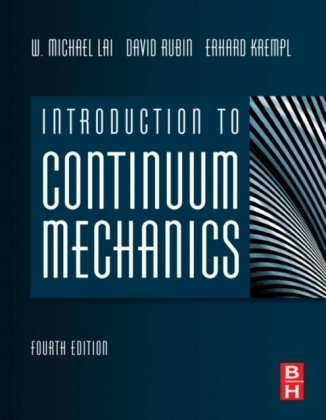
Introduction to Continuum Mechanics
Butterworth-Heinemann Ltd (Verlag)
978-0-7506-8560-3 (ISBN)
Continuum Mechanics is a branch of physical mechanics that describes the macroscopic mechanical behavior of solid or fluid materials considered to be continuously distributed. It is fundamental to the fields of civil, mechanical, chemical and bioengineering. This time-tested text has been used for over 35 years to introduce junior and senior-level undergraduate engineering students, as well as graduate students, to the basic principles of continuum mechanics and their applications to real engineering problems. The text begins with a detailed presentation of the coordinate invariant quantity, the tensor, introduced as a linear transformation. This is then followed by the formulation of the kinematics of deformation, large as well as very small, the description of stresses and the basic laws of continuum mechanics. As applications of these laws, the behaviors of certain material idealizations (models) including the elastic, viscous and viscoelastic materials, are presented.
This new edition offers expanded coverage of the subject matter both in terms of details and contents, providing greater flexibility for either a one or two-semester course in either continuum mechanics or elasticity. Although this current edition has expanded the coverage of the subject matter, it nevertheless uses the same approach as that in the earlier editions - that one can cover advanced topics in an elementary way that go from simple to complex, using a wealth of illustrative examples and problems. It is, and will remain, one of the most accessible textbooks on this challenging engineering subject.
W. Michael Lai is Professor Emeritus of Mechanical Engineering and Orthpaedic Bioengineering at Columbia University. He received his Ph.D in Engineering Mechanics in 1962 from the University of Michigan. Between 1962 and 1986, he was a faculty member in the Mechanical Engineering Department at Rensselaer Polytechnic Institute. He joined the Columbia faculty in 1987 with a joint appointment between the Department of Mechanical Engineering and the Department of Orthopaedic Surgery. He served as Chairman of the Mechanical Engineering Department from 1996 to 2002 and became Professor Emeritus in 2004. His research field has been in Orthopaedic Bioengineering with a special interest in soft tissue mechanics. He is a Fellow of ASME and a founding Fellow of the American Institute for Biomedical and Biological Engineering (1995). Dr. David Rubin is a retired principal and senior scientist at Weidlinger Associates, a former engineering firm in New York City
Introduction
Tensors
Kinematics of a Continuum
Stress and Integral Formulations of General Principles
The Elastic Solid
Newtonian Viscous Fluid
The Reynolds Transport Theorem and Applications
Non-Newtonian Fluids
| Erscheint lt. Verlag | 25.9.2009 |
|---|---|
| Verlagsort | Oxford |
| Sprache | englisch |
| Maße | 191 x 235 mm |
| Gewicht | 1360 g |
| Themenwelt | Naturwissenschaften ► Physik / Astronomie ► Mechanik |
| Technik | |
| ISBN-10 | 0-7506-8560-3 / 0750685603 |
| ISBN-13 | 978-0-7506-8560-3 / 9780750685603 |
| Zustand | Neuware |
| Haben Sie eine Frage zum Produkt? |
aus dem Bereich


